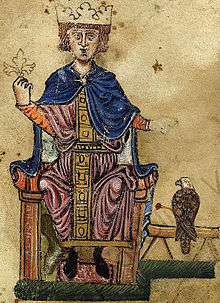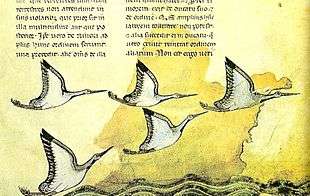De arte venandi cum avibus

De Arte Venandi cum Avibus, literally On The Art of Hunting with Birds, is a Latin treatise on ornithology and Falconry written in the 1240s by Frederick II, and dedicated to his son Manfred. The original manuscript of Frederick II was lost in 1248 at the siege of Parma. Manuscripts of De arte venandi cum avibus exist in a two-book version (Manuscripts at Rome, Vienna, Paris (2x), Geneva and Stuttgart) and in a six-book version (Manuscripts at Bologna, Paris, Nantes, Valencia, Rennes, and Oxford).[1]
Versions
The work is made up six books but only two have been printed based on incomplete manuscripts. All of them have missing parts. There are about seven copies of the Latin manuscript with most famous copy being an illuminated manuscript commissioned by his son Manfred, a two-column parchment codex of 111 folios now in the Vatican Library in the Bibliotheca Palatina[2] The manuscript belongs to the two book version and is illustrated with brilliantly coloured, extraordinarily lifelike, accurate and minute images of birds, their attendants, and the instruments of the art. This manuscript contains additions made by Manfred, which are all clearly marked in the beginning by notations such as "Rex", "Rex Manfredus" or "addidit Rex". A 1596 Latin edition was printed in Augsburg by Velser and reprinted in Leipzig in 1788-89 with commentary by J.G. Schneider.[3]
The first translation of this work was in French and commissioned around 1300 by Jean II, lord of Dampierre.,[4] and the first translation into English (of the six-book version) was by Casey A. Wood and F. Marjorie Fyfe, as The Art of Falconry by Frederick II of Hohenstaufen and published in 1943 by the Stanford University Press.

Content and analysis
This work is notable for the fact that Frederick II mainly confides in his own observations and experiments: he experimented with eggs to see if they would hatch only by the warmth of the sun; he tried to find out if birds used their sense of smell while hunting by covering the eyes of vultures. The author keeps to his intention, formulated in the preface, to describe the things as they are (“que sunt, sicut sunt”). It is a scientific book, approaching the subject from Aristotle, whom he likes to contradict. At the same time it is a scholastic book, minute and almost mechanical in its divisions and subdivisions.[5]
Frederick II was familiar with Aristotle's treatises on animals in Latin translation: Liber Animalum, a translation by Michael Scot, from the Arabic translation Kitāb al-Hayawān. He was also familiar with De Scientia Venandi per Aves, a treatise by the Arab falconer Moamyn, it was translated into Latin at his court by Master Theodore of Antioch, and much copied.[6] The Vatican edition includes illuminations which include nearly 900 images of birds. It also includes figures of Frederick in a Byzantine pose and another, possibly of Manfred.[3] While Haskins wrote approvingly of the bird illustrations and their lifelike appearance, W.B.Yapp found them largely inaccurate.[7]
Notes
- ↑ Wood and Fyfe (1943):lvii.
- ↑ Vatican, MS. Pal. Lat. 1071. Parchment, 111 folios, 360 x 250 mm.
- 1 2 Haskins, C.H. (1921). "The "De Arte Venandi cum Avibus" of the Emperor Frederick II.". The English Historical Review. 36 (143): 337–339. JSTOR 552467.
- ↑ Corrie, Rebecca W (1999). "De arte venandi cum avibus/L'art de la chace des oisiaus.Federico II, Laura Minervini , Hélène Toubert". Speculum. 74 (2): 414–417. doi:10.2307/2887074. JSTOR 2887074.
- ↑ Haskins, Charles Homer (1927). "The Latin Literature of Sport". Speculum. 2 (3): 235–252. doi:10.2307/2847715.
- ↑ Wood & Fyfe (1943):xlviii-xlix.
- ↑ Yapp, W.B (2006). "The illustrations of birds in the Vatican manuscript of De arte venandi cum avibus of Frederick II". Annals of Science. 40 (6): 597–634. doi:10.1080/00033798300200401.
Cited sources
- Wood, Casey A.; Fyfe, F. Marjorie, eds. (1943). The art of falconry : being the de arte venandi cum avibus of Frederick II of Hohenstaufen. London: Oxford University Press.
External links
| Wikimedia Commons has media related to De arte venandi cum avibus. |